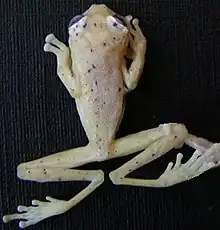Chimerella mariaelenae
Chimerella mariaelenae is a species of glassfrog that inhabits on the Andean slopes of eastern Ecuador and northeastern Peru,[2][4][5] possibly also in the adjacent Colombia.[2] The species was described as new to science by Diego F. Cisneros-Heredia and Roy Wallace McDiarmid.
| Chimerella mariaelenae | |
|---|---|
 | |
| Photo of the holotype | |
| Scientific classification | |
| Domain: | Eukaryota |
| Kingdom: | Animalia |
| Phylum: | Chordata |
| Class: | Amphibia |
| Order: | Anura |
| Family: | Centrolenidae |
| Genus: | Chimerella |
| Species: | C. mariaelenae |
| Binomial name | |
| Chimerella mariaelenae (Cisneros-Heredia & McDiarmid, 2006) | |
| Synonyms[2] | |
| |
Type locality
Collected along a small stream, tributary of the Jambue River, ca. 16 km S from Zamora, Podocarpus National Park (ca. 04º15’S, 78º56’W, 1820 m), on the western slope of Contrafuerte de Tzunantza, Cordillera Oriental, eastern slopes of the Andes, Zamora-Chinchipe Province, Republic of Ecuador.[3]
Diagnostic characters
Chimerella mariaelenae is diagnosed from other species of the family Centrolenidae by the combination of the following characters:[3][5] (1) vomerine teeth absent; (2) bones white in preservative (unknown in life); (3) parietal peritoneum clear without guanophores in a bib-like fashion; guanophores covering on the pericardial, hepatic and visceral peritonea, except for the clear gall bladder; (4) color in preservative, dorsal and flank surfaces cream with many small dark lavender punctuations and scattered larger dark flecks; (5) webbing absent between fingers I and II, basal between fingers II and III, outer fingers III2½–2½IV; (6) webbing on feet I2–2½II2–3III2–3IV2b–1bV; (7) snout bluntly truncate in dorsal view and truncate in profile; notch in lower lip absent; nostrils elevated, indentation between the nostrils; loreal region concave; (8) dorsal skin shagreen; (9) no dermal folds on hands, forearms, feet, or tarsus; (10) humeral spine present in male holotype; (11) tympanum oriented posterolaterally with light dorsal inclination; tympanic annulus rather indistinct; supratympanic fold weak; (12) snout-vent length in male holotype 19.0 mm; females unknown; (13) prepollical spine not protruding externally; unpigmented nuptial excrescence Type I; (14) pair of large, round, flat tubercles on ventral surfaces of thighs below vent; other anal ornamentation absent, ventral skin granular and not enameled; (15) first finger longer than second, (16) liver apparently bulbous (but see Discussion); (17) eye diameter larger than width of disc on finger III; (18) iris grey in preservative; (19) melanophores absent on fingers and toes except for a few at the base of Toe V; (20) the advertisement call is unknown for this species.
Etymology
The specific name of Chimerella mariaelenae is a noun in the genitive case and a patronym for María Elena Heredia, mother of one of the authors that described the species.[3]
Distribution
Centrolene mariaelenae is known from several localities on montane forest on eastern Ecuador and northeastern Peru. It inhabits in old secondary-growth and primary Low Montane Evergreen Forest.[3][5]
References
- IUCN SSC Amphibian Specialist Group (2018). "Chimerella mariaelenae". IUCN Red List of Threatened Species. 2018: e.T135968A516500. doi:10.2305/IUCN.UK.2018-1.RLTS.T135968A516500.en. Retrieved 18 November 2021.
- Frost, Darrel R. (2022). "Chimerella mariaelenae (Cisneros-Heredia and McDiarmid, 2006)". Amphibian Species of the World: An Online Reference. Version 6.1. American Museum of Natural History. doi:10.5531/db.vz.0001. Retrieved 11 May 2022.
- Cisneros-Heredia, D. F. & McDiarmid, Roy W. (2006). "A new species of the genus Centrolene (Amphibia: Anura: Centrolenidae) from Ecuador with comments on the taxonomy and biogeography of glassfrogs". Zootaxa. 1244: 1–32. doi:10.11646/zootaxa.1244.1.1 (inactive 2023-09-15). hdl:10088/2777.
{{cite journal}}: CS1 maint: DOI inactive as of September 2023 (link)Archived 2011-07-21 at the Wayback Machine - Cisneros-Heredia, Diego F. & Guayasamin, Juan M. (2006). "Amphibia, Anura, Centrolenidae, Centrolene mariaelenae: distribution extension, Ecuador". Check List. 2 (3): 93. doi:10.15560/2.3.93.
- Cisneros-Heredia, Diego F. & McDiarmid, Roy W. (2007). "Revision of the characters of Centrolenidae (Amphibia: Anura: Athesphatanura), with comments on its taxonomy and the description of new taxa of glassfrogs" (PDF). Zootaxa. 1572: 1–82. doi:10.11646/zootaxa.1572.1.1.
